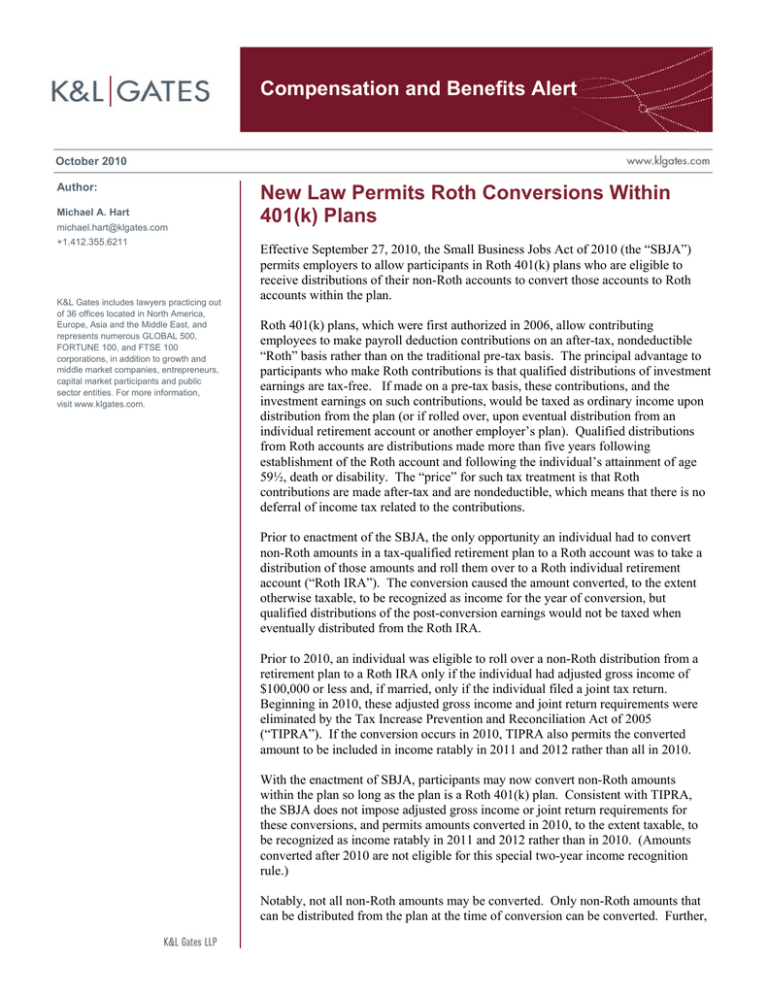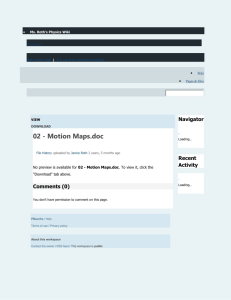
Compensation and Benefits Alert
October 2010
Author:
Michael A. Hart
michael.hart@klgates.com
+1.412.355.6211
K&L Gates includes lawyers practicing out
of 36 offices located in North America,
Europe, Asia and the Middle East, and
represents numerous GLOBAL 500,
FORTUNE 100, and FTSE 100
corporations, in addition to growth and
middle market companies, entrepreneurs,
capital market participants and public
sector entities. For more information,
visit www.klgates.com.
New Law Permits Roth Conversions Within
401(k) Plans
Effective September 27, 2010, the Small Business Jobs Act of 2010 (the “SBJA”)
permits employers to allow participants in Roth 401(k) plans who are eligible to
receive distributions of their non-Roth accounts to convert those accounts to Roth
accounts within the plan.
Roth 401(k) plans, which were first authorized in 2006, allow contributing
employees to make payroll deduction contributions on an after-tax, nondeductible
“Roth” basis rather than on the traditional pre-tax basis. The principal advantage to
participants who make Roth contributions is that qualified distributions of investment
earnings are tax-free. If made on a pre-tax basis, these contributions, and the
investment earnings on such contributions, would be taxed as ordinary income upon
distribution from the plan (or if rolled over, upon eventual distribution from an
individual retirement account or another employer’s plan). Qualified distributions
from Roth accounts are distributions made more than five years following
establishment of the Roth account and following the individual’s attainment of age
59½, death or disability. The “price” for such tax treatment is that Roth
contributions are made after-tax and are nondeductible, which means that there is no
deferral of income tax related to the contributions.
Prior to enactment of the SBJA, the only opportunity an individual had to convert
non-Roth amounts in a tax-qualified retirement plan to a Roth account was to take a
distribution of those amounts and roll them over to a Roth individual retirement
account (“Roth IRA”). The conversion caused the amount converted, to the extent
otherwise taxable, to be recognized as income for the year of conversion, but
qualified distributions of the post-conversion earnings would not be taxed when
eventually distributed from the Roth IRA.
Prior to 2010, an individual was eligible to roll over a non-Roth distribution from a
retirement plan to a Roth IRA only if the individual had adjusted gross income of
$100,000 or less and, if married, only if the individual filed a joint tax return.
Beginning in 2010, these adjusted gross income and joint return requirements were
eliminated by the Tax Increase Prevention and Reconciliation Act of 2005
(“TIPRA”). If the conversion occurs in 2010, TIPRA also permits the converted
amount to be included in income ratably in 2011 and 2012 rather than all in 2010.
With the enactment of SBJA, participants may now convert non-Roth amounts
within the plan so long as the plan is a Roth 401(k) plan. Consistent with TIPRA,
the SBJA does not impose adjusted gross income or joint return requirements for
these conversions, and permits amounts converted in 2010, to the extent taxable, to
be recognized as income ratably in 2011 and 2012 rather than in 2010. (Amounts
converted after 2010 are not eligible for this special two-year income recognition
rule.)
Notably, not all non-Roth amounts may be converted. Only non-Roth amounts that
can be distributed from the plan at the time of conversion can be converted. Further,
Compensation and Benefits Alert
only distributions that are eligible for rollover may
be converted. However, this still provides
significant conversion opportunities:
•
Pre-tax elective deferral contributions can be
converted by active employees after age 59½
(but not before).
•
Employer profit sharing and matching
contributions can be converted by active
employees who have participated in the plan for
at least five years. Active employees who have
participated for less than five years can convert
employer contribution amounts that have
accumulated for at least two years. In “safe
harbor” 401(k) plans, however, active
employees cannot convert their safe harbor
employer contributions before age 59½.
•
Rollover contributions and most non-Roth aftertax employee contributions can be converted by
active employees at any time. While Roth
401(k) contribution features have, since 2006,
made non-Roth after-tax employee contributions
less common, many plans still have significant
non-Roth after-tax employee contribution
account balances. These are accounts for which
the Roth conversion opportunity may be the
most attractive because the contributions in such
accounts can be converted tax-free (though the
earnings attributable to such contributions
would be taxable).
•
Former employees can convert any amount
under the plan.
above, and a few Roth 401(k) plans do not permit
immediate distributions following severance from
employment, such plans generally could be
amended to do so. In addition, the SBJA’s
legislative history indicates that to the extent a plan
does not otherwise permit in-service distributions, a
Roth 401(k) plan can be amended to permit those
distributions and condition those distributions on
their conversion to Roth accounts within the plan.
Accordingly, a Roth 401(k) plan could be amended
to permit in-service distributions for the sole
purpose of allowing Roth conversions. The
qualified plan distribution rules are complex, and
any amendment to a Roth 401(k) plan that permits
conversions within the plan should be carefully
analyzed before proceeding.
* * * * *
The conversion opportunity enacted by the SBJA is
permanent and can, therefore, be adopted by an
employer at any time. However, employers that
wish to give employees the opportunity to take
advantage of the 2010 two-year inclusion rule will
need to act quickly so that employees can make
conversion decisions by December 31st. Before
deciding on any plan change for 2010, employers
will want to coordinate with their plan record keeper
to confirm that required recordkeeping changes can
be made and participant communications can be
distributed in time to allow plan participants
sufficient lead time to consider whether to make
such a conversion. For many plan participants, this
is a complex tax decision and many participants
may choose not to convert.
While many Roth 401(k) plans do not permit all of
the in-service distribution opportunities described
Anchorage Austin Beijing Berlin Boston Charlotte Chicago Dallas Dubai Fort Worth Frankfurt Harrisburg Hong Kong London
Los Angeles Miami Moscow Newark New York Orange County Palo Alto Paris Pittsburgh Portland Raleigh Research Triangle Park
San Diego San Francisco Seattle Shanghai Singapore Spokane/Coeur d’Alene Taipei Tokyo Warsaw
Washington, D.C.
K&L Gates includes lawyers practicing out of 36 offices located in North America, Europe, Asia and the Middle East, and represents numerous GLOBAL 500, FORTUNE
100, and FTSE 100 corporations, in addition to growth and middle market companies, entrepreneurs, capital market participants and public sector entities. For more
information, visit www.klgates.com.
K&L Gates is comprised of multiple affiliated entities: a limited liability partnership with the full name K&L Gates LLP qualified in Delaware and maintaining offices throughout
the United States, in Berlin and Frankfurt, Germany, in Beijing (K&L Gates LLP Beijing Representative Office), in Dubai, U.A.E., in Shanghai (K&L Gates LLP Shanghai
Representative Office), in Tokyo, and in Singapore; a limited liability partnership (also named K&L Gates LLP) incorporated in England and maintaining offices in London
and Paris; a Taiwan general partnership (K&L Gates) maintaining an office in Taipei; a Hong Kong general partnership (K&L Gates, Solicitors) maintaining an office in Hong
Kong; a Polish limited partnership (K&L Gates Jamka sp. k.) maintaining an office in Warsaw; and a Delaware limited liability company (K&L Gates Holdings, LLC)
maintaining an office in Moscow. K&L Gates maintains appropriate registrations in the jurisdictions in which its offices are located. A list of the partners or members in each
entity is available for inspection at any K&L Gates office.
This publication is for informational purposes and does not contain or convey legal advice. The information herein should not be used or relied upon in regard to any
particular facts or circumstances without first consulting a lawyer.
©2010 K&L Gates LLP. All Rights Reserved
October 2010
2



